Niloy Ganguly
Towards Sustainable NLP: Insights from Benchmarking Inference Energy in Large Language Models
Feb 08, 2025



Abstract:Large language models (LLMs) are increasingly recognized for their exceptional generative capabilities and versatility across various tasks. However, the high inference costs associated with these models have not received adequate attention, particularly when compared to the focus on training costs in existing research. In response to this gap, our study conducts a comprehensive benchmarking of LLM inference energy across a wide range of NLP tasks, where we analyze the impact of different models, tasks, prompts, and system-related factors on inference energy. Specifically, our experiments reveal several interesting insights, including strong correlation of inference energy with output token length and response time. Also, we find that quantization and optimal batch sizes, along with targeted prompt phrases, can significantly reduce energy usage. This study is the first to thoroughly benchmark LLM inference across such a diverse range of aspects, providing insights and offering several recommendations for improving energy efficiency in model deployment.
Efficient Continual Pre-training of LLMs for Low-resource Languages
Dec 13, 2024Abstract:Open-source Large Language models (OsLLMs) propel the democratization of natural language research by giving the flexibility to augment or update model parameters for performance improvement. Nevertheless, like proprietary LLMs, Os-LLMs offer poorer performance on low-resource languages (LRLs) than high-resource languages (HRLs), owing to smaller amounts of training data and underrepresented vocabulary. On the other hand, continual pre-training (CPT) with large amounts of language-specific data is a costly proposition in terms of data acquisition and computational resources. Our goal is to drastically reduce CPT cost. To that end, we first develop a new algorithm to select a subset of texts from a larger corpus. We show the effectiveness of our technique using very little CPT data. In search of further improvement, we design a new algorithm to select tokens to include in the LLM vocabulary. We experiment with the recent Llama-3 model and nine Indian languages with diverse scripts and extent of resource availability. For evaluation, we use IndicGenBench, a generation task benchmark dataset for Indic languages. We experiment with various CPT corpora and augmented vocabulary size and offer insights across language families.
Adaptive BPE Tokenization for Enhanced Vocabulary Adaptation in Finetuning Pretrained Language Models
Oct 04, 2024



Abstract:In this work, we show a fundamental limitation in vocabulary adaptation approaches that use Byte-Pair Encoding (BPE) tokenization scheme for fine-tuning pretrained language models (PLMs) to expert domains. Current approaches trivially append the target domain-specific vocabulary at the end of the PLM vocabulary. This approach leads to a lower priority score and causes sub-optimal tokenization in BPE that iteratively uses merge rules to tokenize a given text. To mitigate this issue, we propose AdaptBPE where the BPE tokenization initialization phase is modified to first perform the longest string matching on the added (target) vocabulary before tokenizing at the character level. We perform an extensive evaluation of AdaptBPE versus the standard BPE over various classification and summarization tasks; AdaptBPE improves by 3.57% (in terms of accuracy) and 1.87% (in terms of Rouge-L), respectively. AdaptBPE for MEDVOC works particularly well when reference summaries have high OOV concentration or are longer in length. We also conduct a human evaluation, revealing that AdaptBPE generates more relevant and more faithful summaries as compared to MEDVOC. We make our codebase publicly available at https://github.com/gb-kgp/adaptbpe.
Unlocking Efficiency: Adaptive Masking for Gene Transformer Models
Aug 13, 2024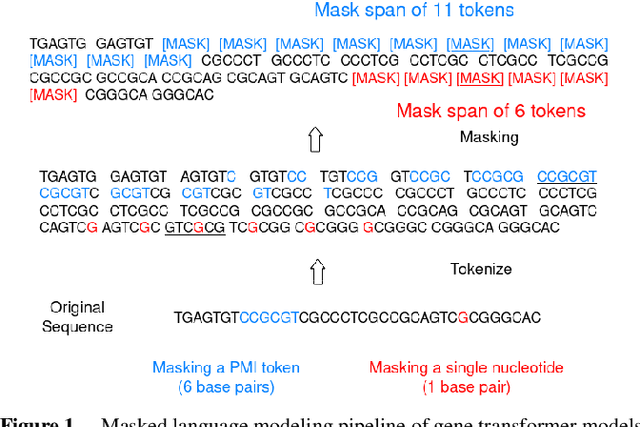

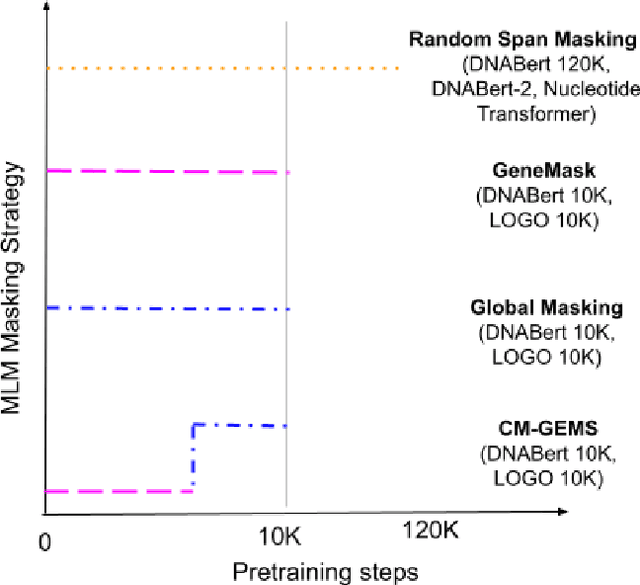
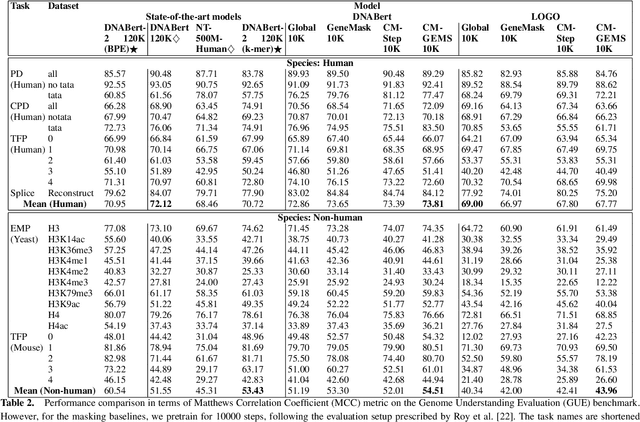
Abstract:Gene transformer models such as Nucleotide Transformer, DNABert, and LOGO are trained to learn optimal gene sequence representations by using the Masked Language Modeling (MLM) training objective over the complete Human Reference Genome. However, the typical tokenization methods employ a basic sliding window of tokens, such as k-mers, that fail to utilize gene-centric semantics. This could result in the (trivial) masking of easily predictable sequences, leading to inefficient MLM training. Time-variant training strategies are known to improve pretraining efficiency in both language and vision tasks. In this work, we focus on using curriculum masking where we systematically increase the difficulty of masked token prediction task by using a Pointwise Mutual Information-based difficulty criterion, as gene sequences lack well-defined semantic units similar to words or sentences of NLP domain. Our proposed Curriculum Masking-based Gene Masking Strategy (CM-GEMS) demonstrates superior representation learning capabilities compared to baseline masking approaches when evaluated on downstream gene sequence classification tasks. We perform extensive evaluation in both few-shot (five datasets) and full dataset settings (Genomic Understanding Evaluation benchmark consisting of 27 tasks). Our findings reveal that CM-GEMS outperforms state-of-the-art models (DNABert-2, Nucleotide transformer, DNABert) trained at 120K steps, achieving similar results in just 10K and 1K steps. We also demonstrate that Curriculum-Learned LOGO (a 2-layer DNABert-like model) can achieve nearly 90% of the state-of-the-art model performance of 120K steps. We will make the models and codes publicly available at https://github.com/roysoumya/curriculum-GeneMask.
Leveraging the Power of LLMs: A Fine-Tuning Approach for High-Quality Aspect-Based Summarization
Aug 05, 2024



Abstract:The ever-increasing volume of digital information necessitates efficient methods for users to extract key insights from lengthy documents. Aspect-based summarization offers a targeted approach, generating summaries focused on specific aspects within a document. Despite advancements in aspect-based summarization research, there is a continuous quest for improved model performance. Given that large language models (LLMs) have demonstrated the potential to revolutionize diverse tasks within natural language processing, particularly in the problem of summarization, this paper explores the potential of fine-tuning LLMs for the aspect-based summarization task. We evaluate the impact of fine-tuning open-source foundation LLMs, including Llama2, Mistral, Gemma and Aya, on a publicly available domain-specific aspect based summary dataset. We hypothesize that this approach will enable these models to effectively identify and extract aspect-related information, leading to superior quality aspect-based summaries compared to the state-of-the-art. We establish a comprehensive evaluation framework to compare the performance of fine-tuned LLMs against competing aspect-based summarization methods and vanilla counterparts of the fine-tuned LLMs. Our work contributes to the field of aspect-based summarization by demonstrating the efficacy of fine-tuning LLMs for generating high-quality aspect-based summaries. Furthermore, it opens doors for further exploration of using LLMs for targeted information extraction tasks across various NLP domains.
On The Persona-based Summarization of Domain-Specific Documents
Jun 06, 2024



Abstract:In an ever-expanding world of domain-specific knowledge, the increasing complexity of consuming, and storing information necessitates the generation of summaries from large information repositories. However, every persona of a domain has different requirements of information and hence their summarization. For example, in the healthcare domain, a persona-based (such as Doctor, Nurse, Patient etc.) approach is imperative to deliver targeted medical information efficiently. Persona-based summarization of domain-specific information by humans is a high cognitive load task and is generally not preferred. The summaries generated by two different humans have high variability and do not scale in cost and subject matter expertise as domains and personas grow. Further, AI-generated summaries using generic Large Language Models (LLMs) may not necessarily offer satisfactory accuracy for different domains unless they have been specifically trained on domain-specific data and can also be very expensive to use in day-to-day operations. Our contribution in this paper is two-fold: 1) We present an approach to efficiently fine-tune a domain-specific small foundation LLM using a healthcare corpus and also show that we can effectively evaluate the summarization quality using AI-based critiquing. 2) We further show that AI-based critiquing has good concordance with Human-based critiquing of the summaries. Hence, such AI-based pipelines to generate domain-specific persona-based summaries can be easily scaled to other domains such as legal, enterprise documents, education etc. in a very efficient and cost-effective manner.
Parameter-Efficient Instruction Tuning of Large Language Models For Extreme Financial Numeral Labelling
May 15, 2024Abstract:We study the problem of automatically annotating relevant numerals (GAAP metrics) occurring in the financial documents with their corresponding XBRL tags. Different from prior works, we investigate the feasibility of solving this extreme classification problem using a generative paradigm through instruction tuning of Large Language Models (LLMs). To this end, we leverage metric metadata information to frame our target outputs while proposing a parameter efficient solution for the task using LoRA. We perform experiments on two recently released financial numeric labeling datasets. Our proposed model, FLAN-FinXC, achieves new state-of-the-art performances on both the datasets, outperforming several strong baselines. We explain the better scores of our proposed model by demonstrating its capability for zero-shot as well as the least frequently occurring tags. Also, even when we fail to predict the XBRL tags correctly, our generated output has substantial overlap with the ground-truth in majority of the cases.
MEDVOC: Vocabulary Adaptation for Fine-tuning Pre-trained Language Models on Medical Text Summarization
May 07, 2024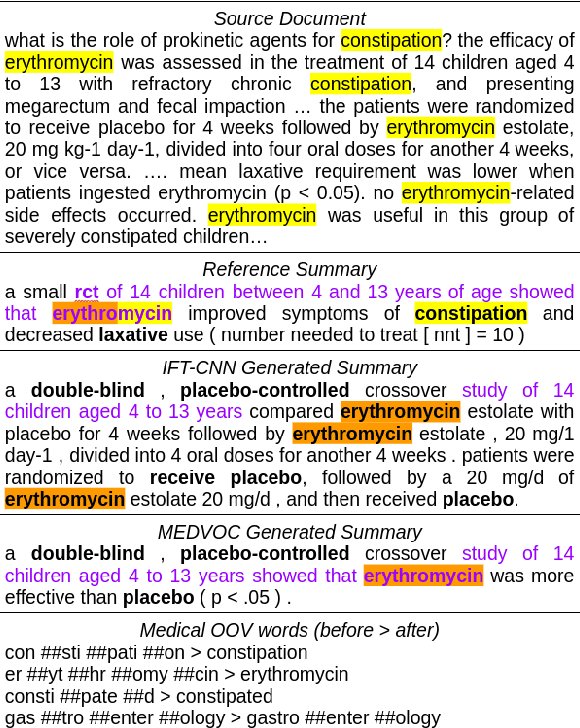
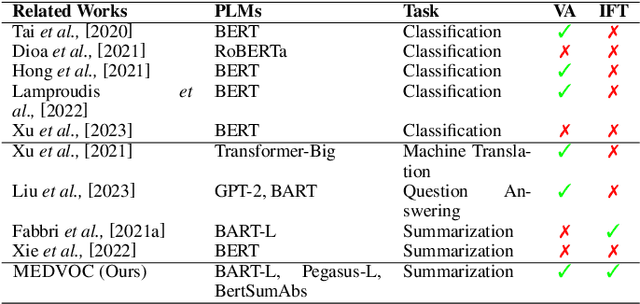
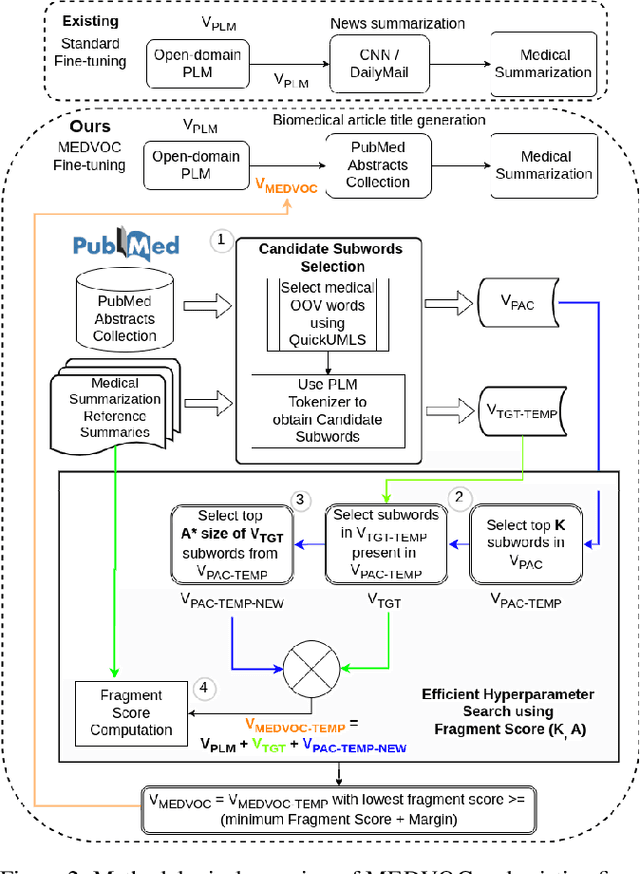

Abstract:This work presents a dynamic vocabulary adaptation strategy, MEDVOC, for fine-tuning pre-trained language models (PLMs) like BertSumAbs, BART, and PEGASUS for improved medical text summarization. In contrast to existing domain adaptation approaches in summarization, MEDVOC treats vocabulary as an optimizable parameter and optimizes the PLM vocabulary based on fragment score conditioned only on the downstream task's reference summaries. Unlike previous works on vocabulary adaptation (limited only to classification tasks), optimizing vocabulary based on summarization tasks requires an extremely costly intermediate fine-tuning step on large summarization datasets. To that end, our novel fragment score-based hyperparameter search very significantly reduces this fine-tuning time -- from 450 days to less than 2 days on average. Furthermore, while previous works on vocabulary adaptation are often primarily tied to single PLMs, MEDVOC is designed to be deployable across multiple PLMs (with varying model vocabulary sizes, pre-training objectives, and model sizes) -- bridging the limited vocabulary overlap between the biomedical literature domain and PLMs. MEDVOC outperforms baselines by 15.74% in terms of Rouge-L in zero-shot setting and shows gains of 17.29% in high Out-Of-Vocabulary (OOV) concentrations. Our human evaluation shows MEDVOC generates more faithful medical summaries (88% compared to 59% in baselines). We make the codebase publicly available at https://github.com/gb-kgp/MEDVOC.
Instruction-Guided Bullet Point Summarization of Long Financial Earnings Call Transcripts
May 03, 2024



Abstract:While automatic summarization techniques have made significant advancements, their primary focus has been on summarizing short news articles or documents that have clear structural patterns like scientific articles or government reports. There has not been much exploration into developing efficient methods for summarizing financial documents, which often contain complex facts and figures. Here, we study the problem of bullet point summarization of long Earning Call Transcripts (ECTs) using the recently released ECTSum dataset. We leverage an unsupervised question-based extractive module followed by a parameter efficient instruction-tuned abstractive module to solve this task. Our proposed model FLAN-FinBPS achieves new state-of-the-art performances outperforming the strongest baseline with 14.88% average ROUGE score gain, and is capable of generating factually consistent bullet point summaries that capture the important facts discussed in the ECTs.
TIGQA:An Expert Annotated Question Answering Dataset in Tigrinya
Apr 26, 2024Abstract:The absence of explicitly tailored, accessible annotated datasets for educational purposes presents a notable obstacle for NLP tasks in languages with limited resources.This study initially explores the feasibility of using machine translation (MT) to convert an existing dataset into a Tigrinya dataset in SQuAD format. As a result, we present TIGQA, an expert annotated educational dataset consisting of 2.68K question-answer pairs covering 122 diverse topics such as climate, water, and traffic. These pairs are from 537 context paragraphs in publicly accessible Tigrinya and Biology books. Through comprehensive analyses, we demonstrate that the TIGQA dataset requires skills beyond simple word matching, requiring both single-sentence and multiple-sentence inference abilities. We conduct experiments using state-of-the art MRC methods, marking the first exploration of such models on TIGQA. Additionally, we estimate human performance on the dataset and juxtapose it with the results obtained from pretrained models.The notable disparities between human performance and best model performance underscore the potential for further enhancements to TIGQA through continued research. Our dataset is freely accessible via the provided link to encourage the research community to address the challenges in the Tigrinya MRC.
* 9 pages,3 figures, 7 tables,2 listings
 Add to Chrome
Add to Chrome Add to Firefox
Add to Firefox Add to Edge
Add to Edge